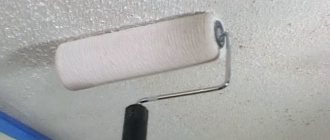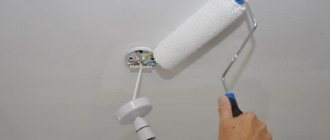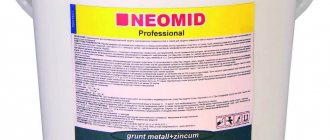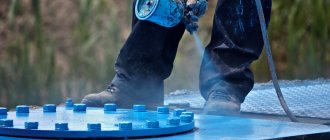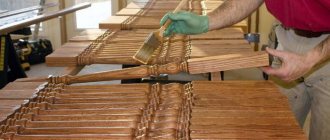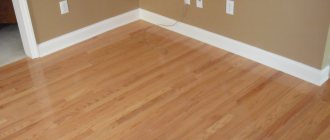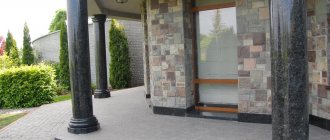Painting metal surfaces is one of the most common types of work. This process helps protect the metal from corrosion and other environmental factors. The surface gets an excellent visual effect. A roller will help you quickly cope with this task. And to get the best result, you should listen to the advice of professionals.
Features of metal painting
Every owner of a private home is faced with the need to paint iron gates or other structures. To do this, you should know some features of the dyeing process. To properly paint metal, it is necessary to carry out some important preparatory measures. Which should be aimed at finding and preparing the necessary working materials, as well as tools.
The correct choice of paint in accordance with the type of metal will help you achieve a high-quality result. The best choice would be dyes that contain anti-corrosion additives and form a dense coating. Traditionally, oil paints are used; acrylic paints or those with epoxy or alkyd bases are also excellent.
Important! Water-dispersed compositions are not used for painting metal.
Before painting metal surfaces, you should prepare not only the paint composition, but also auxiliary tools. They will simplify the painting process:
- primer mixture - it is necessary to form an additional protective layer;
- a separate container for pouring paint - a container for a roller or brush;
- roller, brush or spray gun depending on the surface area and dyes used.
What to paint with?
Today, there are various types of paints and varnishes that can be selected for both wooden flooring and concrete floors. There are two types of products that can be used to cover the floor: colorless and opaque. Clear varnishes are great for wooden surfaces. They are durable and fade resistant, and dry quickly. Decorative varnishes have many tones, thanks to which a wooden surface can be given a beautiful shade without blocking the structure of the wood. Beech, oak and other expensive flooring have a beautiful structural pattern, and a varnish with a translucent or transparent consistency will perfectly highlight it, give it shine and protect it from moisture.
It is worth remembering that the varnish is not resistant to various mechanical damage, and therefore it is better not to cover surfaces in rooms with high traffic. Otherwise, it is worth applying additional impregnations.
Do not use this product on flooring made of soft wood (spruce, pine). It is better to treat them with paint that maximally protects the surface from mechanical damage.
Preparing metal before painting
After all the necessary tools and materials have been collected, the preliminary preparation of the metal surface begins. Thanks to this, you can simplify and speed up the dyeing process.
High-quality preparation will help you avoid mistakes in your work, which are very difficult and sometimes impossible to correct.
Procedure:
- The base is cleaned of accumulated dirt, dust, as well as remnants of the previous decorative layer. To do this, use a metal brush or sandpaper. It is better to avoid applying a new layer to an old one, even if the color is identical.
- Degreasing of metal. The process begins by removing contaminants using a solvent or white spirit. It is necessary to treat the entire area to be painted, without skipping particularly difficult areas. After which the surface is washed with a soap solution, which is easily washed off with plain water. The result should be a clean and dry coating.
- If there are visible cracks and depressions, it is necessary to putty. Before this, all defects are covered with anti-corrosion compounds. The putty should not be applied everywhere, but directly to the desired areas. The mixture is applied as evenly as possible and requires sanding to achieve a perfectly smooth surface.
- The corrosive layer is removed using a converter, which forms a protective film and prevents damage.
- The remaining minor defects are removed by grinding and stripping.
The metal surface is considered prepared if all steps are performed consistently and the surface is thoroughly dried.
Choosing a roller for painting a metal surface
The roller allows you to speed up the painting process and at the same time distribute the paint evenly over the surface and make the coating smooth. For each situation, a certain type of tool is selected depending on the type of surface and its area. It is worth considering the type of design, size, and material of the roller coat. Which roller should I use to paint metal?
Since metal surfaces are usually large in size, universal rollers are more often used. Alkyd and oil-based paints and varnishes are used to paint metal; therefore, it is better to choose a tool coat from synthetic or natural raw materials. The length of the fur coat's pile depends on the roughness of the surface to be painted. Therefore, for metal, short or medium-length pile is used, the height of the pile is 5-11 mm. Such tools use paint more economically.
Types of rollers and fur coats
According to the domestic classification, paint rollers are divided into:
- VMP – fur nozzle for painting floors.
- VP is a foam nozzle designed for water-based adhesive compositions.
- VMU – natural fur. The product is intended for painting corners.
- VM – fur covering.
According to the classification of foreign manufacturers, rollers are:
- PE – polyester based
- N – based on natural material
- PC – from polyacrylic modifications
- PA – from varieties of polyamides
So, depending on the material of the working surface, the roller coat is:
- Polyamide - made of artificial fiber with increased wear resistance to abrasion and chemical attack.
The main purpose is the application of water-dispersion paints. The length of the pile is 8 - 20 mm, and the longer it is, the easier it is to apply the coating to a rough surface. - Polyacrylic (acrylic) – has a dense pile, which reduces paint splashing during operation. Made from polyacrylonitrile, which is a synthetic fiber reminiscent of wool, and in most respects it is the same as the previous version.
Attention!
It is not intended for working with materials with aggressive components, which means it is suitable for applying water-based paints.
- Polyester - polyester, reminiscent of padding polyester. Extremely cheap to produce, has excellent absorption and retention properties.
When working on the surface being treated, it does not leave lint. The advantages are compensated by low mechanical resistance and the same durability. - Fur is a generalized name for two types of fur coats. Thus, the option made from natural fur is made from sheep wool and is suitable for treating any surface with varnishes, enamels, water-dispersion, and oil paints.
NOTE:
Not recommended for use with lime-based compounds.
Options made of faux fur - vestan, are used for applying any type of paint, and therefore are universal.
- Velor - plush pile is supported by a fabric base.
Suitable for finishing work on smooth surfaces. Tolerates solvents well. - Foam rubber. It is used for applying water-based varnishes, as well as water-dispersion paints. Essentially, this is polyurethane, which, among its other technical characteristics, has a density, the indicator of which is directly dependent on its service life.
The fur coat does not cake and quickly restores its original shape. The fibers are arranged in such a way that during operation they leave small air bubbles, which means an uneven final surface. - Flock is a textile base with glued polyurethane fiber. Features include strength, environmental friendliness of the material, and water resistance.
- Nylon is a representative of polyamide, which means it has the same properties.
- Felt is an environmentally friendly soft fur coat, suitable for various types of surfaces.
Felt copes well with paints based on aggressive solvents. - Thread - a roller made of fluffed nylon or polyacrylic thread, another name for a thread coat. Designed to work with water-based and oil-based paints.
- Rubber - most often the pressure roller is designed to expel air and increase adhesion when gluing wallpaper.
- Made of microfiber - suitable for working with antiseptics, impregnations, primers, glazes, as well as water-based paints. Microfiber has good absorbency and impact; it is used when processing both completely smooth surfaces and those with slight roughness.
They also use silicone coats for applying decorative patterns and leather coats for working with Venetian plaster.
Latex paints require a synthetic coat.
As for the rollers, the most common materials used are plastic and aluminum, and less commonly, wooden ones.
Rollers with plastic rollers are generally the cheapest due to their ease of manufacture.
It should be noted that the roller may have a connecting seam or be seamless.
The latter option is preferable, since otherwise the movement of the roller along the surface to be treated is hampered at the seam site, which leads to disruption of the uniformity of the applied paint layer.
The presence of a seam is also eliminated by the so-called circular knitted base of the fur coat with a uniform layer of roller coating.
Fastening fur coats
Depending on the type of attachment of the fur coat to the roller, the tool can be:
- Glued – with a non-removable working surface. A narrow strip of fur coat is wrapped around the base with glue applied, forming a joint joint to joint. This type of fur coat fastening system is seamless, since the seam runs in a spiral, which means that the paint is applied evenly during operation.
- Thermo-glued - the fur coat is soldered into a cylindrical base. The design is more durable and reliable due to the absence of glue.
- Sewn - rectangular fabric sewn to fit the shape of a sleeve.
- With a replaceable coat.
In the latter case, a quick-release system of one of the options is used to attach the fur coat:
– Rod (clasp) – a monolithic handle with a rod onto which a roller with a rotation and fixation device mounted inside is placed. The simplest option.
– Frame – the fur coat is fixed on a roller made in the form of a hollow cylinder-frame. The clasp contains bearings on which the equipment is installed. That's why this tool is called a frame roller.
There is also a so-called special fastening system, implemented on long rollers.
The rectangular frame has an axis secured by means of a thread, onto which a roller with end bushings is mounted.
Metal painting technology
How to paint metal surfaces correctly? Painting methods depend on the tools used. In some cases, a combination is used.
To paint hard-to-reach, embossed products, brushes are used - this process is quite labor-intensive and time-consuming. The roller is used for processing large and flat surfaces. Particularly large objects are painted with a spray gun.
Let's take a closer look at the roller painting technology:
- For easier distribution, the coloring composition is diluted with a suitable solvent.
- The resulting mixture is poured into a suitable container. The container size must be larger than the width of the roller.
- To avoid visible transitions, you must move in one direction. This will help achieve even coloring.
- A dampened paint roller is applied to the surface, and then rolling begins. The first movements are in the vertical plane, the intensity of pressure gradually increases. An area several times larger than the size of the roller is immediately painted.
- Work continues until the surface is completely painted.
Important! When painting with a roller, more than one layer of paint should be applied to the metal, after each previous layer has completely dried.
Painting metal is a rather complex process that requires the necessary knowledge, skills and free time. You should take safety precautions very seriously to maintain your health. By listening to professional recommendations, you can get the desired result in the shortest possible time.
